"Time's Eye" A Time Odyssey, Book One by Arthur c. clarke and Stephen Baxter
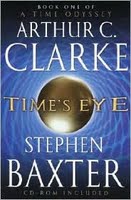
"Time's Eye"
A Time Odyssey, Book One
by Arthur c. clarke and Stephen Baxter
read by John Lee
Produced by Blackstone Audio
Unabridged Approx. 11.5 hours
When It comes to science-fiction there are some authors that just have to be read. Any true sci-fi fan has read at least one Arthur C. Clarke novel, the most often mentioned would be "2001, a Space Odyssey." "2001..." was only book one of what turned out to be a four book odyssey in Arthur C. Clarke's future vision of religion, intelligence and mystery. This time around Sir Clarke has teamed up with Stephen Baxter to create another odyssey through space and time.
The total series came out to three books but the third book was published as the final chapter in the series and yet did not conclude the plot. The final book was published in December of 2007 and Arthur C. Clarke died in March of 2008 so we may never really know if there was a fourth book intended. However each of these books can be read as independent works of great science-fiction.
Blackstone audio has recently produced the first book, "Time's Eye," with John Lee as the reader. John Lee does what seems like a nearly impossible task of singlehandedly voicing the characters and brings them to life by using a diverse range of accents. This is no easy job since the characters range from British soldiers from the 1880s, ancient Greeks, Macedonians, Babylonians, Mongolians, Afghanis, Russians and Texans. John Lee keeps each character separate with their own accent and attitude.
The premise of this book creates a great "What if?" scenario. What if Alexander the Great were to battle Ghengis Khan? That question is answered in what turns out to be a great mashup of historical figures in a new world.
The story begins with an Australopithecus being (the possible missing link) observing a silver orb in the sky. She is then captured by British Empire (circa 1880) soldiers who are guarding a fort in India. The discovery of this strange creature and the floating silver orb is interrupted by the crash of a strange flying object. This object turns out to be a U.N. peacekeeper helicopter with its 3 crew members from the year 2037. The British Soldiers investigate the crash and soon befriend the crew, even though 2 of the crew turn out to be of Indian and Afghan descent.
After talking with each other the time castaways figure out they are some how in a strange timeslip that has something to do with these suddenly appearing "eyes," the silver orbs. Soon the 2037 castaways, the moderns, discover that they are not the only ones from 2037. Floating above the Earth, or whatever this newly formed planet consisting of slices of various times from Earth's history is, a Russian Soyuz capsule is returning from the space station and gets caught in the timeslip and returns to earth. They contact each other using ham radios and more is learned as the 2 cosmonauts and one astronaut from Texas, send pictures from space of the new planet they dub "Mir."
With no ground control the Soyuz capsule lands in the middle of Mongolia. The ruler of the nomadic tribes of Mongolia is the great Genghis Khan. One of the warlords immediately beheads one of the cosmonauts, leaving the other two to think fast. They go to Genghis Khan as emissaries of Heaven. Back in India, the armies of Alexander the Great meet up with the British soldiers and the first band of Moderns. Both groups decide to trek to Babylon, since that is the location of a mysterious radio signal each group of Moderns has detected.
After many months the two groups reach Babylon to battle for rights of the land.
In what turns out to be a very interesting social commentary on the ideas of peace and humankind's ability to hold the peace, Arthur C. Clark and Stephen Baxter have created an intriguing time odyssey.
Labels: arthur c. clarke, audio book, audiobook, blackstone audio, book review, books, sci-fi, Science-Fiction, stephen baxter, time odyssey, time travel, time's eye
posted by Gil T. @ 9:02 PM


"Dune: House Atreides" by Brian Herbert & Kevin J. Anderson
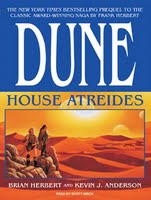
"Dune: House Atreides"
by Brian Herbert & Kevin J. Anderson
read by Scott Brick
Produced by Tantor Media
approx. 26.5 hours
Back in 1999, Brian Herbert discovered some manuscripts left behind with more information on the universe of Dune, written by his father Frank Herbert. Teaming up with Kevin J. Anderson they began a quest to add more stories to the "Duneverse" based on these manuscripts and their own talents in writing Science Fiction. The first was the "Prelude to Dune" series. This book "House Atreides" was the first in this series.
Tantor Audio has re-released these books in audio book form and this time they aquired the award winning voice of Scott Brick. Back when I first started listening to audio books Scott Brick was the first reader I heard. After hearing his performance I became a huge fan of audio books. There's a reason Mr. Brick has won so many awards. His voice is completely adjustable to any genre and his talents are fully expressed when reading a book with multiple characters. When expressing the voice of another speaker in the dialogue in the book he can, with the subtlest of changes, change characters so the listener is treated to what nearly sounds like a multi-cast performance. At the same time he can add the characters emotions into the voice to the utmost perfection. Scott Brick is no stranger to the "Dune" series, he has voiced many of the audio books so he knows the material and I would have to say he is the perfect choice for the re-issue of these books.
"House Atreides" gives some information on the buildup of what created the situations leading to the epic novel "Dune," by Frank Herbert.
An aging tyrant emperor rules the known universe, Emperor Elrood Corrino IX, and his son Shaddam IV, cannot wait for him to die, so that Shaddam may become emperor. He and his minion, Hasimir Fenrig devise a slow poison to kill off the old man so Shaddam may sit in the "Golden Lion Throne."
While this is going on Elrood has some schemes going that could change the universe. Spice Melange, only found on Arrakis (Dune), is needed for the Spacing Guild to fold space, it prolongs life, and is highly addictive. "He who controls the spice, controls the Universe." So Elrood has set out to devise an alternative to spice. Teaming up with the genetic scientist race of the Tleilaxu, Elrood has commissioned them to develop the newly engineered spice. As payment to the Tleilaxu, Elrood plans a takeover of the machine planet IX, where in place are the facilities for such a genetic engineering feat. To do this the House Vernius must be defeated. Instead of laying back and being defeated the house goes renegade, meaning they are no longer supported or recognized by the league and are criminals. The children are sent to Calidan to live with Duke Paulus Atreides. They are raised along with the Duke's son, Leto Atreides.
Meanwhile the Bene Gesserit discover they are only 2 or 3 generations from the Kwisatz Haderach, a prophesied messiah figure. But first they must get Baron Vladimir Harkonnen to "donate the genetic material." The first union of a Bene Gesserit sorceress and Harkonnen is deformed and must be repeated. This time Harkonnen violently rapes the sorceress and in the process she curses him with an incurable disease.
On Caladan, Paulus Atreides dies during a bullfight with a drugged Salusan Bull, and Leto becomes Duke. House Harkonnen has developed a ship that renders itself invisible. And frames House Atreides for an attack on the Tleilaxu.
In the meantime on Arrakis, Dune, Pardot Kynes a planetologist sent by Emperor Elrood, arrives on Arrakis and begins his duties there. He starts to dislike the Harkonnen rule there, and is getting more and more interested in the native Fremen of the desert and the possibility of terraforming the planet. Pardot is discovering more and more proof that some time, long ago, Arrakis was covered with giant oceans, and gets curious about what changed the climate to what it is today.
Once again another book filled with lots of material lots of action and great political interaction.
Labels: audio book, audiobook, book review, books, brian herbert, dune, frank herbert, house atreides, kevin j. anderson, prelude to dune, sci-fi, Science-Fiction, scott brick, tantor audio
posted by Gil T. @ 9:48 PM


Planet of the Apes by Pierre Boulle originally published in 1963
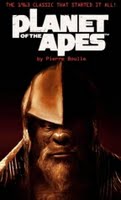
Planet of the Apes
by Pierre Boulle
originally published in 1963
This 2000 edition published by Gramercy Books
Recently I set myself down in front of my television and watched a marathon of all the "Planet of the Apes" movies and was amazed at how they were still good after all these years. I also noticed how some of the social commentary was still applicable. While watching the credits roll on all the films I kept seeing that they were all based on the novel by Pierre Boulle, and being the avid reader/autodidactic I am, I decided to read the novel. This novel is a classic, I've discovered and should be required reading for our youth because, while the 6 films touched on some social commentary, issues like racism, class divisions, vivisection, and the dangers of close-mindedness, Pierre Boulle had all this wrapped in this one 191 page novel.
Basically if you take all the concepts from the films (except for "Beneath the Planet of the Apes") you get this one story. It's odd how all the films have a touch of some of the original novel but not one single movie had all the action/concepts. Also only 4 characters from the book made it to the original 70s era movies and Tim Burton's Planet of the Apes from 2001 added one more character from the novel. Those characters are; Cornelius, Zira, Zaius, Nova and Hector. In the 2001 film Hector played an important part but in the novel the Earth chimp is killed not long after landing on the Planet of the Apes.
Here's the story in a nutshell. Jinn and Phyllis, a couple out on a pleasure cruise in a spaceship, find a message in a bottle floating in space. The message inside the bottle is the testimony of a man, Ulysse Mérou, who has written down his story in the hope that someone else, somewhere, will find it. Ulysse begins by explaining that he was a friend of Professor Antelle, a genius scientist on Earth, who invented a spaceship that could travel at nearly the speed of light. Ulysse, the professor, and a physicist named Levain fly off in this ship to explore outer space. They travel to the nearest star system that the professor theorized might be capable of life, the red sun Betelgeuse, which would take them about 350 years to reach. Due to time dilation, however, the trip seems to the travelers only to last two years.
Upon landing on this planet in the Betlguese system, which they name Soror, the astronauts see signs of civilization but find that the humans are like wild animals living in the jungle and without the ability of speech. After the humans discover the astronauts they go wild and attack the landing craft, destroying it and the clothes, which the humans don't wear on this planet. The astronauts "go native" in order to understand this society. Soon it is discovered that the humans aren't the dominate race, when a gorilla hunting party begins trapping and killing humans.
Ulysse manages to escape being killed only to be trapped, caged and taken to some chimpanzee scientists. Levain is killed and the fate of Professor Antelle is unknown at this time.
Ulysse at first observes the ape culture then finds an ally in Zira, a chimpanzee scientist. Zira and Cornelius (her fiance), plan to show Ulysse at a scientific forum, to help prove Cornelius theories of evolution. Soon Ulysse becomes somewhat of a celebrity among the apes and is treated like an ape (like the apes were in "Escape from the Planet of the Apes"). Not long after Ulysse is exposed to the ape culture, a strange archaeological site is found to show that humans were once the dominant species and that out of laziness became the lower life form and the apes took over in an uprising (like in the last 2 movies of the original series;"Conquest..." & "Battle...").
Soon Zira, Cornelius and Ulysse learns the scientists want to destroy all evidence of humans once being dominant, that includes Ulysse, so they plan his escape. One thing at this point I should point out is that the Apes on Soror are not the same as in the movies, they are technologically advanced and just beginning to send satellites into space. Yep, the apes drive cars and fly planes.
This book has a great twist ending, although it is nowhere near the Charlton Heston scene with the Statue of Liberty, it is a bit of a surprise.
Labels: book review, books, charlton heston, planet of the apes, sci-fi, Science-Fiction
posted by Gil T. @ 10:33 PM


“When Shadows Fall” by L. Ron Hubbard
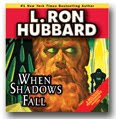
“When Shadows Fall”
by L. Ron Hubbard
Multicast performance
Produced by Galaxy Press
Approx 2 hours
Once again I sit back with an audio book and have some fun. This time it's as if I'm jumping back in a time machine and going back about 50 or so years, and picking up some science-fiction pulp stories. That's right it's another L. Ron Hubbard audio book collection of his short stories. Hubbard wrote many short stories during the '30s through the '50s, they range in genre from westerns to sci-fi, from fantasy to piracy, and every one of his early stories have been packaged up in both book and audio book form. They consist of two or three stories within the same genre to fill up the audio book with two hours of listening pleasure.
Galaxy audio has produced the audio books with multi-cast performances, sound effects and incidental music that not only assist in the story telling but also give the feel of the times the stories were written. The characterizations from the performers' voices create an ambiance that boosts you into a jet pack and thrusts you into the hey day of sci-fi storytelling.
This collection, "When Shadows Fall" includes the following stories; the title story "When Shadows Fall," "Tough Old Man," and "Battling Bolto." Each one has the L. Ron Hubbard twist to the end that leaves the listener smiling or saying, "hmmm...." or both. Either way they are very fun to hear.
"When Shadows Fall" tells the story of Earth after most of its population has left to colonize the universe leaving the planet depleted of its natural resources. The few inhabitants have very little food, fuel, air or water. The Earth president and council decide to make a last ditch effort and pool all remaining resources to send out among the stars to ask for help. They only come up with enough for three expeditions each led by a completely different personality, one a military leader, another a financial leader and the third an artisan/story teller. Will any of these expeditions be able to gather help to save Earth?
"Tough Old Man" is an adventurous and fun story about a man named Moffat who is sent for final training under the Senior Constable of the Frontier Patrol, old Keno. All the others sent to train under old Keno have returned to turn in their badges because they couldn't keep up with the old man. Moffet is determined. He powers through the severities of the planets climates of extreme cold, extreme heat and rocky landscape. What it takes to be Senior Constable is a a surprise to Moffat.
"Battling Bolto" is a hilarious space age snake oil salesman story. A young hick is hired as a smith to create robot skins for a man selling robots to planets on the fring, you know, backwoods planets. He soon dons one of the robot skins and is set out to deceive the hicks by acting as a fighting robot. This one has one of the best twists I've ever read in a story and is a must listen.
So go on out pick up the collection "When Shadows Fall" and have some fun with an audio book.
Labels: audio book, book review, books, l. ron hubbard, pulp fiction, pulp magazines, sci-fi, Science-Fiction, when shadows fall
posted by Gil T. @ 8:25 PM


"The Professor was a Thief" by L. Ron Hubbard
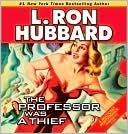
"The Professor was a Thief"
by L. Ron Hubbard
Multicast performance
Produced by Galaxy Press
Approx 2 hours
Remember the days of the "Pulps?" The small magazines that printed short stories that ranged from westerns to pirate adventures to science-fiction were a staple for many readers during the early part of the 20th century. I was always a fan of comic books and on occasion bought the Isaac Asimov monthly magazines. But the real pulps preceded comic books, with titles like "Fantastic Adventures" and "Astounding Science-Fiction." Well L. Ron Hubbard wrote many stories that appeared in many of those pulps and now Galaxy Press is putting those stories together in collections of two or three stories in one book or in this case in one audio book. Let me tell you not only are they interesting stories but they are very fun to hear.
In this audio book there are three fun science-fiction stories written in the 1930s through the 1950s. The title story in the collection, "The Professor was a Thief" was even adapted as a radio play for the early 50s radio program "Dimension X."
"The Professor was a Thief" is about an ace reporter, Pop, as he is called by the staff, who is being forced to retire from a New York newspaper and before his retirement he is demoted to less important stories. Pop is given a magazine article about a physicist that has been shunned by the scientific community. It seems the professor has some outrageous claims about making the shipping industry almost otherworldly. After visiting the eccentric professor at his home, Pop is shown the professor's train collection which is in a room that is a scale model of the United states. the trains are there but no cities. Pop leaves not finding a decent story in the case and finds himself back in the office when calls begin coming in about major New York landmarks disappearing, Grant's Tomb, Pennsylvania Station and the Empire State Building completely gone. Soon Pop discovers the professor has a secret and that he is a thief.
The second story in this collection "Battle of Wizards," is a fun science-fiction story that pits Science up against Magic. Earth’s Mineralogy Service has its sights set on Deltoid, a planet rich in “catalyst crystals in a natural state.” Angus McBane, a Civil Affairs officer, is sent to Deltoid to resolve the conflict between the humans and the planet’s native inhabitants. This sets the stage for a battle between science (McBane) and magic (a local tribal chief). The winner gets rights to the planet and it's resources.
Finally we come to the third story in this audio book, "The Dangerous Dimension." This story is a humorous story with a touch of a morality tale. This is the story of a professor who discovers an equation that allows him to teleport himself anywhere he can imagine, whether he wants to or not. It is actually a pretty funny little story and does bring to question if someone discovers such a thing should the knowledge be shared.
The voice work, music and sound effects in this production all work together to give the listener an authentic mid-20th century pulp magazine feel.
Labels: audio book, battle of wizards, book review, books, l. ron hubbard, pulp fiction, pulp magazines, sci-fi, Science-Fiction, the dangerous dimension, the professor was a thief
posted by Gil T. @ 9:23 PM


"Juggler of Worlds" by Larry Niven & Edward M. Lerner
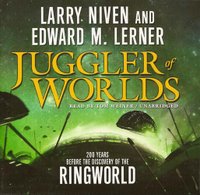
"Juggler of Worlds"
by Larry Niven & Edward M. Lerner
Read by Tom Weiner
Produced by Blackstone Audio
Approx. 13 Hours.
Be prepared to be whisked away from word one in this prequel to Larry Niven's classic sci-fi "Ringworld." I have yet to read the Ringworld series of books, but I found this book, being a prequel, did not rely on the series being required reading. This novel takes place 200 years before Ringworld and has a very interesting view of "Known Space."
"Juggler of Worlds" starts out jumping around from moment to moment, year to year, location to location. At first it was a bit hard to follow but once the story got rolling, all the pieces slipped in to place and the story was easily followed and understood. The first half of the book is basically and explanation as to why the characters act as they do in the first half.
This audio book is read by Tom Weiner. Tom's deep voice makes the book easy to listen to and his characterizations of the various humans and aliens helps to keep the story flowing with a good understanding as to who is speaking and thinking.
Sigmund Ausfaller is an Agent for the U.N. More specifically he is a highly valued Agent of the Amalgamated Regional Militia (A.R.M.). What makes him so valuable is that he is a Paranoid. Sigmund is perfect for rooting out conspiracies because he sees conspiracies in everything. The U.N. has several paranoids that are used to uncover conspiracies, these are all made to be paranoid through drugs. Sigmund is a natural paranoid, that's what makes him unique and actually better at the job.
Sigmund meets Nessus, an alien from the race known as The Puppeteers. The Puppeteers are an older race in Known Space and have sold most of the human race technology. Their biggest contribution is known as an indestructible hull space craft. Nothing (except light and gravity) can permeate the hulls thus creating a bit of peace in the universe. Nessus soon becomes Sigmund's adversary after all the Puppeteers mysteriously vanish from known space. The reason suspected is that the center of the galaxy is exploding.
After an indestructible hull returns in a deteriorated state the mystery of what could destroy the indestructible adds on to Sigmund's suspicions of the dissappearance of the Puppeteers. With an exciting chase through hyper-space and beyond Sigmund is determined to find out what is motivating Nessus and the Puppeteers .
Various jumps in space and various characters may seem confusing at first but the mystery unfolds itself with a very nice payoff to end this intelligent science fiction novel. The various aliens; including the Puppeteers, Kzinn and the Outsiders are well thought out races, especially for those of you who, like me, always wondered why every alien in Star Trek is bi-pedal. Here they are not in fact they are creatively constructed in "Juggler of Worlds."
Do yourself a favor and escape into this well written and well read audio book.
Labels: audio book, book review, books, edward m. lerner, juggler of worlds, larry niven, ringworld, sci-fi, Science-Fiction
posted by Gil T. @ 8:19 PM


Brave New World by Aldous Huxley
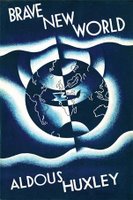
Brave New World
by Aldous Huxley
Read by Michael York
Produced by BBC Audiobooks America
approx 9 hours
Every so often I go back and read one of those books that you HAD to read in school. Whether high school or college, if they were on the reading/study list they had to be boring. Many of these books I found interesting but with the added feature of having to analyze and dissect these books it seemed to take away the enjoyment of just reading a good book. I went back to the shelves a couple of years ago and re-read "Moby Dick" and actually enjoyed that book.
This time around I decided on going back and re-reading "A Brave New World." At the time I decided to do that I found an audiobook version read by Michael York, and decided to give that a try. After all, It's the guy from "Logan's Run" reading it...I know some of you say the guy from the Austin Powers movies, but I enjoyed "Logan's Run" more and I like to show my age.
So after years of intense study & dissecting of this book in High School and in Freshman English @ SIU, I won't be overanalyzing this book. Been there, done that, even got a t-shirt. Instead let's talk about this book in generalities and for enjoyment purposes.
"A Brave New World" is one of those dystopian society books that warns us as humans what we may be headed for. (Oops starting to analyze here.) In this future society people are not born but are decanted from bottles in large factories. In these factories they separate the different castes of humans by slight chemical additions or deletions from the bottles on the assembly line. Through years of study scientists discovered that not everyone can be the super-smart Alpha plus plus, who would do the grunt work? So Epsilons are developed to do said grunt work. The other castes are Betas, Gammas and Deltas with varying degrees in each, signified by a plus or minus in their cast.
Also in this future history is ignored, for it is the past and the past is gone. The center of worship is not God but Ford (as in Henry, the man that perfected the assembly line) and Freud. At times the two are referred to as the same.
The society is kept at bay by doses of a drug called Soma. Soma the effects of Alcohol & Christianity without all the guilt.
The story centers around Bernard Marx who, rumor has it, accidentally had alcohol added to his bottle which stunted his growth and as an Alpha plus he's not as beautiful as the other Alphas. Bernard is a psychologist (specializing in hypnopædia). Hypnopædia is the sleep therapy that conditions infants and children to develop into loving society. Bernard decides to take his annual holiday to the savage (non-modernized) lands in New Mexico, USA.
Short and sweet he brings back a savage that is the son of a member of modern society that got lost in the savage lands and spent a number of years raising her son in the savage lands. In this future the concept of a Mother is similar to pornography and highly detested.
The savage in short revolts against the non-self-thinking society after the death of his mother. As a result Bernard and a colleague of his are exiled to islands of self-thinkers. The savage tries to isolate himself but the "natives" of London bring their Soma and celebrate the visual image of the savage with Soma induced orgies.
Interesting science-fiction and social commentary all rolled into one in this book. Michael York delivers this book with ease and grace. Being that London is the center of society in this book Mr. York's accent adds believability and his voicework keeps the characters separated and unique. So do yourself a favor and just read this book for fun. I found that reading it just for fun I actually was able to absorb the social commentary a little easier and could actually analyze the book with more ease.
Labels: aldous huxley, audio book, book review, books, brave new world, future, michael york, sci-fi, Science-Fiction, utopia
posted by Gil T. @ 8:56 PM


"One Second After" by William R. Forstchen

One Second After
by William R. Forstchen
Read by Joe Barrett
Produced by Blackstone Audio
Approx 13.5 hours
Are you prepared for a natural disaster? What about a natural disaster that wipes out the entire United States of America's fundamental way of life? We all like to say that we have learned something from the disaster of hurricane Katrina or even the attacks of 9/11, but those disasters had something in common, we could turn on the television or radio and find out information and we knew help was eventually on the way.
"One Second After" by William R. Forstchen explores another aspect of an attack on the U.S, one that hits us in our soft underbelly, our lives in the modern age of electronics. Most of the world, especially the U.S, have come to rely on our electronic creature comforts, computers, television, diabetic monitors, pacemakers. In "On Second After" those are completely wiped out. There is a weapon in existence that can take this out, an EMP weapon. EMP stands for Electro-magnetic pulse, It was actually a side affect of a nuclear blast and the pulse created from early tests of nuclear weapons found that electronics were severely affected by these pulses rendering them useless. Today the electronic circuitry in every day devices have become more complex and more susceptible to this type of attack.
In this cautionary tale 3 nuclear missiles are detonated in the atmosphere above the United States and the U.S. is rendered useless. Every electronic device ceases to work, computers, phones, radios, cars and medical equipment. Basically anything with a chip in it ceases to function.
This story follows the citizens of Black Mountain, North Carolina as they fight for survival in what has turned the clocks back to medieval times. The town of Black Mountain is home to a small college which has a former Army colonel, who retired to be with his wife in her final days as she died from cancer. He is now teaching and raising his two young daughters in small town, U.S.A.
Once the power is out the community must reform its thinking to a survival mode, no supplies will ever come in, no one knows what is going on outside of city limits and only a small handful of cars will run. The town takes to rationing food and medical supplies as the population dies off from disease and starvation. They then begin to rebuild and try to survive with makeshift soup lines from the area's cattle farms and what little food can be hunted in the mountains.
Just when the town starts to level out from the deaths of those that would normally be treated at modern facilities, a horde of what used to be "gang-bangers" threaten the town. This threat is some of the more violent dregs of society getting by with what they know and are cutting a swath of death and destruction to loot the towns to survive. The most vicious of crimes this "gang" perpetrates is that of cannibalism.
Most of the issues explored in this story are told through the impacts of one family surviving. This creates a personal feel to the story and I was completely swallowed up by their exploits. The story even had me wondering, "What would I do?" and "How can I prepare myself?"
Joe Barrett delivers this audiobook with a great voice that easily gives you that hometown storyteller comfort and yet delivers the entire gamut of emotions in this story.
With the forward written by Newt Gingrich and the afterword written by Capt. Bill Sanders, USN. The reality of this situation is really hit home. Not a matter of If but When. While this may be what seems a sci-fi tale of a post apocalypse world, it does have its basis in reality. Be careful listening to this audiobook, you'll find yourself fully absorbed by the story and planning your survival at the same time.
Labels: armageddon, audiobook, book review, books, emp, end times, one second after, post-apocalypse, sci-fi, Science-Fiction, war, william r forstchen
posted by Gil T. @ 9:24 PM


The Green Hills of Earth By Robert A. Heinlein
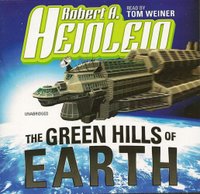
The Green Hills of Earth
By Robert A. Heinlein
Read by Tom Weiner
Produced by Blackstone Audio
Approx. 6.5 Hours
Some say that there was a simpler time when the year 1984 was in the distant future and the year 2000 was the stuff good sci-fi could speculate about. Maybe this was an innocent time and the exploration of worlds within our solar system would become a priority before the mythical year 2000, or maybe this was just the perfect time to write science-fiction. Either way Robert A. Heinlein was one of the masters of sci-fi that took the genre seriously. Heinlein’s stories not only gave the reader some fun reading but he also wrote stories that seemed very probable without getting too technical, and always seemed to have something more to say about humanity.
The Green Hills of Earth is a collection of some of Heinlein’s short stories that dwell on social aspects of the future. From the idea of women working alongside men, to the use of indentured servitude with focus on slavery and slave masters on plantations of Venus. Heinlein takes a look at human sociology through some fun to read sci-fi stories. Even with the title story, human social interaction is explored through a blind folksinger deadheading his way across the universe writing his swan song, “The Green Hills of Earth.”
Tom Weiner’s vocal aptitude is put to the test on this collection of short stories with many characters, attitudes and storylines. And put simply he passed that test. His vocalizations really make the different characters and situations stand out.
If you are up for some classic science-fiction writing and go out and grab this audio book and meet one of the masters of sci-fi.
Labels: audiobook, book review, books, robert a. heinlein, sci-fi, Science-Fiction, the green hills of earth
posted by Gil T. @ 9:53 PM


Danger in the Dark By L. Ron Hubbard
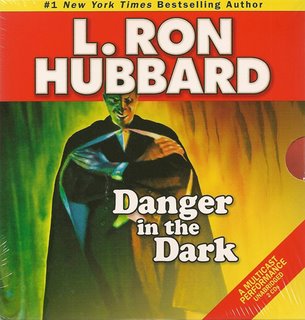
Danger in the Dark
By L. Ron Hubbard
Multicast Performance
Produced by Galaxy Audio
Remember the old Science Fiction and Fantasy magazines? You know the ones that featured short stories written by great sci-fi authors. This audiobook was like going back to those old pulps and reliving the golden age of sci-fi. This audiobook contains 3 short stories written by L. Ron Hubbard that are as diverse in subject matter as they are fun to listen to.
The production is a multicast performance complete with music and sound effects and featuring the actress Karen Black. The other voices are R.F Dailey, Christina Huntington, Jim Meskimen, Gino Montesinos, Noelle North, and Josh R. Thompson. All the voices throughout the stories in this audiobook along with the music and sound effects create an aura about this production that makes it easy to get lost in the simple and fun stories.
The main story is the title story, “Danger in the Dark.” It tells the tale of Billy Newman, who strikes gold and buys an island in the Philippines. He gets the island at a bargain price and later finds out why. The natives all fall ill and crops begin to fail and the tribal chiefs blame Billy for angering the god Tadamona. Tadamona is a 75 foot god that runs the island and unless Billy can come up with stronger “magic” he will destroy the island.
The next story is a fun fantasy called “The Room.” A small town veterinarian goes missing. The last time he was seen was entering his room. This room is one that was his exclusively and no one was to clean, ever. After his disappearance, the veterinarian’s nephew inherits the room to find that things are not as they seem in this room.
The third story, "He Didn't Like Cats," is a morality tale along the lines of Edgar Allen Poe’s “Tell Tale Heart.” A man, who as the title says, doesn’t like cats, comes across the cat and gives it a quick kick. The cat falls into the street and is run over by a vehicle. Before it dies it howls in pain to the point that it almost sounds human. The ordeal shakes the man up a bit and is haunted by the cat through the rest of the night.
These are some great sci-fi/fantasy stories from the late 30s to the early 40s and the production on this audiobook make this an entertaining listen.
Listen to the audio review below.
Click here to get the MP3 podcast file from sfsite.com

Labels: book review, books, danger in the dark, fantasy, golden age, he didn't like cats, l. ron hubbard, mp3, podcast, sci-fi, Science-Fiction, the room
posted by Gil T. @ 8:51 PM


Heretics of Dune by Frank Herbert audiobook review
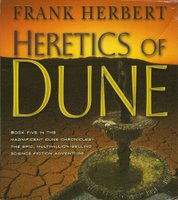
Heretics of Dune
by Frank Herbert
Produced by Macmillan Audio
Read by Simon Vance
What makes the original Dune series by Frank Herbert a classic in all science fiction is the fact that Frank Herbert created not only a story, but several religions, cultures and conflicts. Every book in the series works around the politics of these and yet still has something to say about today's society (no matter when that "today" is).
This audiobook production is read by Simon Vance. His reading not only keeps the listener in the complicated and twisting storyline but his vocal qualities create great characterizations that at times the production seems like a multicast recording.
The Heretics of Dune presents another view in the "Duneverse" this time exploring the meaning and purpose behind the emotion (and all that goes with it) of love. The heresy, which all the heretics presented in this book are guilty of, is Love. The Bene Gesserit have a breeding program in which the genetic line of the Atreides is preserved. No Bene Gesserit witch is allowed to fall in love. After all that is what Lady Jessica did in the original novel, and that created a Kwisatz Haderach, a being that could be in all places at once, and later the tyrant, God Emperor, Leto II.
The book takes place 1,500 years after the reign of Leto II. Arrakis, Dune has returned to being the desert planet, thanks to the sandtrout of Leto II's destruction bringing back the sandworms from extinction. The planet is now called Rakis. Another planet of note, Geidi Prime, former homeworld for House Harkonnen is now known as Gammu.
The empire fell into chaos before the return of the sandworms, due to the scarcity of spice. This created the "Scattering" in which many of the population sought the extreme edges of the universe to find other sources of spice or to expand the location of humanity. As the books opens many people have returned and have changed. There is a new force to deal with, the Honored Matres, they are very similar to the Bene Gesserit but the Matres use sex as a weapon and force of rule. The Bene Gesserit and Bene Tleilax see this as threat and somewhat team up to fight these Honored Matres.
The Bene Gesserit have been using gholas of Duncan Idaho through the years but the Tleilaxu always assassinate the ghola. A ghola is a clone that is capable of full memory of their past self. This time will be different, the Bene Gesserit have a plan. But, as it seems so do the Tleilaxu. They have "programmed" the ghola to kill the Bene Gesserit "imprinter" that tries to imprint him to guarantee his loyalty to the Bene Gesserit.
In the meantime on Rakis, a child is discovered by the priests that can control the sandworms. The Bene Gesserit hear of this and immediately take over Rakis, in order to make the child, Sheeana, a Reverend Mother, and maybe to breed with the Duncan ghola.
The Honored Matres also find this out and seek to destroy the ghola and the girl and Rakis. So with many battles to ensue we are introduced to a retired Bashar, Teg, who is brought out of retirement to not only guard the ghola but to awaken his memories due to Teg being the exact likeness of Duke Leto I. After awakening the ghola Teg, Reverend Mother Lucilla, who was supposed to imprint Duncan before the awakening, and Duncan are discovered on Gammu and have to go underground to get to Rakis. Teg is captured and tortured by the Honored Matres but during the torture some strange powers are awakened in him. He is able to speed his body and mind outside the normal flow of time, and able to destroy all occupants in a Honored Matres stronghouse. He then steals a no-ship (which is a ship undetectable by all, including prescience vision) and takes Lucilla and Duncan to Rakis.
With many plots entangled into one final outcome this book is yet another great representation of the "Duneverse" created by Frank Herbert.
Labels: audiobook, book review, books, dune, frank herbert, heretics of dune, macmillan audio, sci-fi, Science-Fiction
posted by Gil T. @ 1:22 AM


"Judgment in Death" by J.D. Robb (2000)
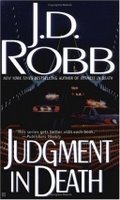
"Judgment in Death"
by J.D. Robb
published byBerkley (2000)
It's been a while since I read one of the "...in Death" series of books by J.D. Robb (a.k.a. Nora Roberts) so I picked up this book from earlier in the series. It was like visiting an old friend. NYPSD Lt. Eve Dallas and her rich and powerful husband Roarke make a great crime solving team. Lt. Dallas works homicide and has a reputation for kicking butt and always solving the case. Roark owns pretty much everything on and off-planet. I say off planet because these books throw in the sci-fi twist to what are great detective novels. This book takes place in the Spring of 2059, which being that close in the future you still get real cop work being done, yet being far enough in the future that there are some real cool gadgets (automated cars, lasers, super cool computer systems and 'droid maid service).
Now, on with the story. Lt. Dallas is called to a murder scene in a strip club called "Purgatory" to find the place trashed and a dead body lying in a pool of blood. The victim was bludgeoned to death and the scene was made to look like a robbery gone bad. But Eve doesn't buy that. Roarke doesn't either looking around he notices that the expensive liquors were smashed rather than stolen and fenced, and surrounding the body are several credits, 30 to be exact. Roarke is on scene to Eve's dismay because, as usual, this is a property he owns. Eve turns the body over to discover that the victim was lying on his badge. The badge is intentionally covered in blood. With these symbols; blood on the badge, and 30 "pieces of silver", Eve realizes this was no robbery but that a statement is being made.
On her way home from the scene she is confronted by former lover now Internal Affairs officer Webster. Webster drops hints for Eve to follow the money. Looking in to the victim's financials, it appears as though he was receiving large somes of money. The money seems to be coming from Ricker, a crime boss in New York that once had a shady relationship with Roarke.
After another cop's body is found Eve now has two crimes to close, finding the cop-killer and bringing down the crime boss that is funding these bad cops. The problem is that the first victim was a plant by Internal Affairs to find all the cops on the take and that the IAB was trying to make him look bad to cover themselves. Eve discovers that another precinct seems to be the breeding ground for corrupt cops and one of their own is killing off the bad cops. So before anymore bodies show up Eve and Roarke (who also becomes a target of Ricker) use pure instinct, cop know how, and great gadgets to catch a cop-killer and bring down Ricker.
Once again this book is full of the great characters that are prominent in these novels. You've got the trusty, although sometimes sarcastic aide to Lt. Dallas, Officer Peabody, Electronics Division Captain Feeney, and NYPSD psychologist/profiler Dr. Meara. A great team of great personalities are what make these books worth the read.
Labels: book review, books, crime, eve dallas, in death, j. d. robb, judgement in death, lt. eve dallas, nora roberts, nypsd, roarke, sci-fi, Science-Fiction, thriller
posted by Gil T. @ 9:41 PM


"Reunion in Death" by J. D. Robb Published by Berkley, 2002
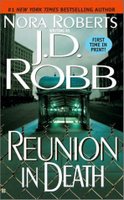
"Reunion in Death"
by J. D. Robb
Published by Berkley, 2002
Once again Nora Roberts, er...ummm...I mean J.D. Robb has created a exciting futuristic detective novel in the "...in Death" series. This book, like most of the other books in this series, starts out running and never lets up until the villain is caught. (Not much of a spoilere there, really, because Lt. Eve Dallas, NYPSD always gets her man, or in this case woman.)
Before I get to the meat of the story of this book I would like to point out a few things. The characters in this series of books are awesome! They are so realistic and their relationships are very human and work well to show the human side to drama. The action in these books usually is up and down but with this one it never lets up.
I really only have one complaint with these books but really it's not much of one. It has to do with the graphic sex scenes throughout all the books in this series. I understand Eve and Roarke really love each other and are a very physical married couple and I understand that Nora Roberts is a romance writer, but jeez, enough already. These books are perfect science-fiction detective novels with great character development but I feel the books are cheapened by the bodice-ripping sex scenes. I keep looking for Fabio on the cover. I have a hard time convincing people to keep reading these books when they get to the sex scenes. Some of the scenes described could make a Licensed Companion (LC) blush. In the future prostitution is legal as long as they are licensed. It really is for me an abrupt stop in the story when Eve and Roarke start having sex and the details of such scene is drawn out in explicit detail. Okay yeah I know now after reading most of the series to skip ahead about 10 pages, but .....c'mon!
One other thing but this is on the cool side of stuff. For anyone who has read any of the novels or my reviews, you know that Lt. Eve Dallas' husband Roarke owns nearly everything on and off planet. But in this novel we learn he has a holodeck. How cool is that? A holodeck! I love this guy.
Okay, here's the story. In this book Lt. Eve Dallas and her husband Roarke return to New York rested from a vacation. Eve is eager to get back to work in the madness and mayhem that is homicide in NYPSD. When she returns to her desk she finds her office has been cleaned and painted and all her paperwork filed. Is it pixies? Nope, Officer Peabody took initiative and finished all pending paperwork and cleaned Eve's office while she was away, but only after Peabody and EDD Detective McNabb came back from a vacation funded by Roarke.
Since there are no pending cases or paperwork, Eve opens up the cold case file and finds one that seems solvable, and proceeds to give Peabody her first case to fly solo on. But just as they return from interview a dead woman's husband there's a ruckus in the bull pen in homicide division and a faint smell of baked goods....hey, cops and doughnuts, even in the future they go hand in hand. Anyway, the baked good culprits are Officer Peabody's parents dropping in for a surprise visit. The visiting Peabodys wrangle their way in to staying in Eve's & Roarke's mansion. Now Eve has to do the one thing she detests most, entertain guests.
Luckily she becomes busy when a man is murdered and Eve is called on the case. The man was poisoned at his birthday party in plain sight of all the guests. Eve soon learns that one of the catering staff left the scene. The staff member is identified as Julianne Dunn, a woman who Eve had put in prison for murdering her three husbands, a black widow who likes to poison her husbands and take off with their riches.
This time Julianne Dunn is seeking revenge on Eve, the only woman that ever bested her. To do so she targets Roarke but before she takes away Eve's man she sends the Eve and her staff chasing red herrings, other murdered men that fit no pattern.
What turns out to be a global romp with great action and great detective work "Reunion in Death" is another superb sci-fi cop thriller that can get you hooked on this series. So if you like/don't mind the sex scenes go ahead and read them but if you think they are just fluff and serve little purpose (like i do) skip over them and enjoy an action packed thriller.
Labels: eve dallas, in death, j. d. robb, lt. eve dallas, nora roberts, reunion in death, roarke, sci-fi, Science-Fiction
posted by Gil T. @ 10:04 PM


"Valis" by Philip K. Dick audiobook review

Philip K. Dick
Valis
Read by Tom Weiner
Blackstone Audio
Approx. 8 1/2 hours
Audiobook published 2008
Valis is the first of Philip K. Dick's three final novels (the others are Divine Invasion and The Transmigration of Timothy Archer) and seem to cover PKD's final days searching for the meaning of life within religion. This book fits not only into the science fiction category, but could also fall easily into the philosophy realm, because the book consists of the main character discussing the origin of God and the purpose of life while suffering through mental illness.
The reader, Tom Wiener, has a very pleasant voice that adds a bit of a feel of authority while reading through the many sections. The book covers times when the main character is locked up in a county mental hospital, writing and quoting from his exegesis (his book on trying to find God), hanging out with his friends and discussing theology and finally meeting what could be the messiah of our time. When Weiner reads the scripture-like quotes from the exegesis they sound like real scripture being read from a pulpit, which definitely makes listening to this book more interesting and easier to absorb the philosophies.
Valis takes place in the 70s in the United States, and may be semi-autobiographical. One hint at the autobiographical feel is that the book is written in both first and third person. In first person the narrator refers to himself as Philip the sci-fi writer and refers back to some of his books. When the narrator shifts to third person he refers to the character Horselover Fat. It is revealed that Horselover Fat is actually part of PKD's schizophrenic split personality and all his friends treat them as 2 different people and hope for him to be cured eventually. Another semi-autobiographical aspect is in the name Horselover Fat. "Horselover" is English for the Greek word philippos (Φίλιππος), meaning "lover of horses" (from philo "brotherly or comradely love" and hippos "horse"); "Fat" is English for the German word "dick".
Valis is about a group of friends' search for God, who turns out to be a virus, a joke, and a mental hologram transmitted from an orbiting satellite. The friends are very reminiscent of the friends in the book "A Scanner Darkly," especially in their very humorous dialogues about God. Basically the friends are all former stoners who have stopped doing dope and now have philosophy as their new drug.
The main character of the novel, Horselover Fat, is thrust into a theological quest when he receives communion in a burst of pink laser light. From the mental ward of a bay area hospital to the ranch of a fraudulent charismatic religious figure/rock musician where they confront the Messiah: a two-year old named Sophia. She confirms their suspicions that an ancient, mechanical intelligence orbiting the earth has been guiding their discoveries. who turns out to have a direct com link with God,
Truly, Valis is an eye-opening look at the nature of consciousness and divinity as PKD leads us down the twisted paths of Gnostic belief, mixed with his own bizarre and compelling philosophy. For an exciting sci-fi trip through theology and philosophy with some great humor thrown in pick up Blackstone Audio's recording of Valis by Philip K. Dick.
Labels: philip k. dick, philosophy, sci-fi, Science-Fiction, theology, valis
posted by Gil T. @ 8:39 PM


Doctor Who – The Evil of The Daleks

Doctor Who – The Evil of The Daleks
Written by David Whitaker
Multicast performance starring Frazer Hines
Published by BBC Audiobooks America
Running time 2 hours 51 minutes
Published 2007
One of the many things that got me on the path to loving science fiction was my exposure to “Doctor Who” every Saturday night on PBS (at least in my hometown). Doctor Who was a time and space traveler with many dimensions to his character. He also had many incarnations through the years, which provided a plausible explanation when different actors portrayed him. Although all of the doctors were unique and well-worth watching, I will have to admit my favorite was Tom Baker. He’s the one who portrayed the doctor with the long scarf and the frizzy hair.
The series was set up as somewhat of a sci-fi soap opera, or better yet, a television serial, with a cliffhanger at the end of every episode. One unique aspect of older programs is the “cheap” special effects, which, by today’s standards, are completely unbelievable. Fortunately, they really didn’t drive the story so viewers forgave them and sometimes got a good giggle. Now, if you were to take away the visual effects, every episode is brilliant storytelling. With writers such as David Whitaker the concepts in the world of the Doctor make for some dramatic science fiction. So, what happens if you take the visuals away from the series? A very interesting and fun audiobook from BBC Audio, that’s what.
This production is more than a single narrator reading a TV script adaptation – it’s an audio performance that lets you experience the broadcast using the recording of the original soundtrack (combining the voices from the TV show with the music and sound effects) along with added narration that describes scenes and provides the set-up for action sequences. The narrator, Frazer Hines, should feel right at home because a much younger Hines is the actor who portrays the Doctor’s assistant in this particular TV episode. Using the original soundtrack, the listener is treated to the voice of the second incarnation of the Doctor, portrayed by Patrick Troughton. Also experienced is the full effect of the loud dischordant voice of the Daleks, a treat in itself. So, with the story narrated and the voices of the original actors, it becomes pretty much a radio play, which makes for some fun sci-fi listening. As a side note, the original copy of this television broadcast was destroyed in the 60s but, due to fan efforts, the audio was saved, which allowed the creation of this audiobook.
The episode begins with the Doctor and Jamie trying to track down thieves who stole the TARDIS (Time And Relative Dimension(s) In Space – it is a time machine and spacecraft used by the Doctor). After some mysterious and “too convenient” clues the Doctor and Jamie track down an antiques dealer whose antiques are authentic but new. This leads the Doctor and Jamie to be captured by the dealer and the Daleks and taken back in time to 1866. During their stay in 1866, the Doctor is forced to trick Jamie into passing some tests for the Daleks so the “human factor” can be extracted by the Dalek’s to use in their plans to conquer humankind.
With clever twists and deceptions, the performance finally leads to the Dalek home planet of Skaro, where the Doctor intends to defeat the Daleks once and for all. Can he do it? Ahh… I will not give that away, Enjoy this audiobook and you will find out. This audiobook will bring back some great memories for Doctor Who fans of all ages and could create some new ones with a great science-fiction time traveling adventure with Doctor Who.
Listen to the audio review below.
Click here to get the MP3 podcast file from sfsite.comOr click on the graphic below for other sci-fi audiobook reviews...some by me..some not.

Labels: audiobook, bbc, book review, books, daleks, doctor who, fiction, sci-fi, Science-Fiction
posted by Gil T. @ 2:48 PM


"Loyalty in Death" by J.D. Robb (published by Berkely, 1999)
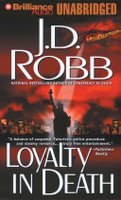
Once again we join New York's best homicide detective in the year 2059, this time it's not really a real homicide case that Lt. Eve Dallas is thrust into. Sure, there are dead bodies and a murder mystery for this kick-butt future cop to solve but this time a lot more is at stake and the culprits are terrorists.
Before I go too far with this one I would like to ponder with you; Why was it that beginning a few years before the attacks of 9/11 several authors were writing about terrorist attacks in New York or via aircraft? Chuck Palahniuk, Kyle Mills and J.D. Robb are just three that come to mind at the moment, but wow...that's a coincidence. Palahniuk and Mills had to go back an rewrite their books to not get too close to the actual attacks. Okay side venture over, let's get back to talking about "Loyalty in Death."
The beginning of the book gives us a simple little warning from a terrorist group calling themselves "Cassandra." "We are Cassandra, We Are Loyal," is how they begin every communication. Cassandra seems to be an off-shoot of a terrorist group from after the "Urban Wars" known as "Apollo." "Apollo" had terrorized the nation seeking to take over the country by blowing up landmarks and all ending with the destruction of the Pentagon, after which the leader was killed and nothing further was heard from "Apollo." If you know your mythology the you know Apollo to granted Cassandra the gift of prophecy and Cassandra foresaw the destruction of Troy. But this warning is that Lt. Dallas may be a problem in their plans so they have to take her out, or in the least, keep her busy, and busy she is.
One of the best tool and toy maker's on and off planet, J. Clarence Branson, has just been murdered by his wife by one of his company's own drills. The wife Lisbeth Cook, is very calm about the whole deal, she found out he was cheating and in a fit of rage, she uses the drill to stick him to the wall. She remarks, "that model IS very reliable." Something doesn't sit right with Eve on this one, and not just the fact that she gets the murder charge knocked down to murder 2 and will hardly do any jail time. More is fishy when Lisbeth gains a nice couple hundred million dollars from J. Clarence's will. This does not go over well with J. Clarance's brother and business partner B. Donald Branson.
At the same time Eve gets a communique from "Cassandra" saying that a building will be blown up. All this while Eve is investigating the mysterious death of an underground electronics expert by the name of "Fixer." Just thinking of all this work makes my blood pressure rise, but it's all in a day's work for Lt. Dallas, Eve, NYPSD.
Throughout the book Eve Dallas solves 3 murders, and attempts to thwart the destruction of several New York city landmarks. On top of all this her Aide, Officer Peabody, discovers she and Electronics Division Detective McNabb share a mutual interest, each other. Also, Peabody's brother comes to town and is set up in another murder. Let's not forget Eve's husband Roarke, being the richest man on and off planet may keep him busy, but he's always ready to use his former criminal side to assist with the detective work, besides, he has the coolest toys and gadgets.
Lots of action in this one and a very fast paced book, you won't want to put it down. I will note that in the earlier publications of the book World Trade Center Twin Towers were one of the landmarks set for destruction by the terrorists, but in the audiobook that reference is removed. I think the same was done with all printings of the book after 2001.
Labels: cops, crime, in death, j. d. robb, loyalty in death, nora roberts, Science-Fiction, thriller
posted by Gil T. @ 8:58 PM


The Road to Dune by Brian Herbert, Kevin J. Anderson, Frank Herbert (published by Tor Books, 2005)
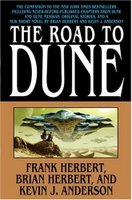
Any true science-fiction fan can tell you that one of the classics of Sci-Fi is the Dune Series created by Frank Herbert. If you have taken it upon yourself to read the entire series you'll remember that Frank Herbert died and left the series a real cliffhanger. Some dedicated dune fans will say that is what he intended but some will say he had more to write. Frank Herbert's son, Brian has teamed up with another sci-fi author, Kevin J. Anderson and working with Franks notes and stored treasures left behined have brought the Dune series to a close. They have also augmented the series with some great prequels also using ideas they found in Frank Herbert's many writings, and to this day they are adding more stories and books to the Duneverse with the recent publication of "Paul of Dune." (note: I'll be reviewing this book soon...I have the audiobook sitting on my shelf waiting for my devouring.
So we've got more stories and the Duneverse continues but what led to the coming of the classic that is "Dune?" Well that brings us to this review. Not only did Brian and Kevin find story plotlines in the cache of documents left behind by Frank Herbert, but they found many other treasures, some including rejection letters. This book is a multi-treat for science fiction fans and die hard Dune fans. In this collection there are letters from publishers about why "Dune" would not be a good book and would never sell. Also included is the original story that Frank Herbert wrote called "Spice Planet" which is the basis of what would be "Dune." This is the original and even though the basic story is still there, this novella doesn't grasp the environmentalism, religion and politics as the final does. I'm glad he rewrote it.
The surprising thing about this book is that so many publishers turned down the book, not because of being a bad story, but because the book was so long. In fact the original publisher, Chilton, published only automobile manuals and took a chance that worked out well for them.
Included in this book is the original, never published news story about stopping sands from destroying coastal towns in Oregon which got Frank Herbert scheming of a planet of sand. Other goodies in the book are some short stories by Brian Herbert and Kevin J. Anderson, three of them bridging the gap between the 3 books covering the Butlerian Jihad, and one taking place during the Harkonnen takeover on Dune in the original first novel, "Dune."
This book is a very nice compliment to the Duneverse, in that it provides insight into the mind of Frank Herbert and the development of the famous spice planet, Dune, and some added stories that add to the thousands of years covered throughout all 14 (now 15) books.
Labels: book review, books, dune, frank herbert, road to dune, Science-Fiction
posted by Gil T. @ 1:26 PM


"Rant: An Oral Biography of Buster Casey" by Chuck Palahniuk (Published by Doubleday, 2007)
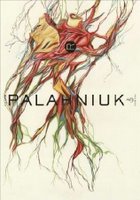
The last book I reviewed by Chuck Palahniuk ("Choke"), I remarked about how I love non-linear story telling and that I appreciate especially the non-linear works of Mr. Palahniuk. This book I think was the perfect non-linear book. At first though I was let down by the time-line structure. Basically the book is a history of the would-be / could-be messianic character of Buster "Rant" Casey, told through anecdotes from various characters who knew Rant or in some cases technical/governmental advisers. It's not until about halfway through the book that you realize the beginning may be the ending, or the ending may be the middle or the end may be, or the middle may not have ever happened, or any combination thereof. At this point in reading, the book became more of a dark humorous novel to something of weird existentialism.
Basically Buster Casey's mom becomes pregnant with him at the age of 13 by what could be a stranger or maybe the man she later marries, Chet Casey. The rumors through the small town of Middletown, run rampant about the family, so anything could be true. As Buster grows up he leads a not so normal childhood. In order to either perpetuate or dispel myths told to little children, Buster creates some strange scenarios. Take for example the tooth fairy myth.
There is a time in Middletown's history when a squirt gun cost $50 and a candy bar could cost $500. This inflationary period is started by Buster Casey. When walking with his grandmother to church, a strange man tells Buster that he is his real father, and proceeds to tell Buster how he can receive untold wealth. Just after he tells him this, Buster's grandmother is bitten by a black widow spider in her church bonnet and dies. After this Buster and a friend gather empty paint cans from the townsfolk for a recycling drive for scouts. In some of these cans are rare coins worth thousands and hundreds of thousands of dollars. When a kid loses a tooth in town Buster would give the the kid a coin in which the kid would replace with the one from a parent. This could would be worth thousands and the parents couldn't say anything, because after all they are the ones that started the whole tooth fairy myth, and asking where the coins came from would be to admit to the lie of the tooth fairy, then Santa Claus, the Easter Bunny and so on.
One year, on Halloween, Buster earns his nickname of "Rant." Every year the city puts on a Halloween haunted house and party. In the Haunted house the children dip their hands in cold macaroni and olives while blindfolded and told they are touching guts and eyeballs. (Remember those days of childhood?) Well Buster decides to spend some of his new found fortune and makes a rather large purchase from a local slaughterhouse. This Halloween the eyeballs, guts, blood etc. are real. The kids are covered in cows blood and guts at the party which is at the end of the maze that is the haunted house. The cake becomes covered in blood from eager hands, costumes become darkly stained from kids wiping off the sticky mess. Finally someone finds out that it is all real and a grand pukefest begins that covers the blood covered community center with a fresh layer of puke. Buster is then called Rant. Rant being the sound you make when you puke up when all has been puked.
Now keep in mind this history of Rant is told through the folks that were there. The book has many more such incidences until Rant finally graduates (or bribes his way out of high school) and moves to the city. This is the point where not only do you start to fully realize the non-linear aspect of the story but also a story of a futuristic distopian society in which there is a class war between those that live/work during the day (daytimers) and those that live/work during the night (nighttimers).
The nighttimers are the lower of the class system and the daytimers look down their noses to nighttimers.
Rant invades the nighttimer society not only throwing it in turmoil but also throwing daytimer society into turmoil along with it. Rant takes up with Party Crashers. These are nighttimers that in order to have fun they crash cars into each other, then milk the event by pretending to get out and argue with each other.
The pasttime of party crashing was started by the government when the government was trying to find ways to make traffic move more smoothly. The first thing the government found was the the biggest slowdown in heavy traffic was not the crash but the rubberneck effect of the passersby. They found this by having agents intentionally crash into each other and then record the results. Finding the rubberneck effect was the slowdown they then created DRVR Graphic Traffic Radio. A Radio station that not only told of wrecks but took calls from paramedics, police and rescue personnel and report on the injuries and describing them in full gory detail.
Well Graphic Traffic soon became a reporting station for the thrill seeking Party Crashers. The Party Crashers have rules, you can only crash into other Party Crashers, and to alert that you are Party Crashing you had to decorate your car to that night's theme. Honeymoon nights are when you decorate your car with shaving cream / tin cans etc. and write Just Married on your car, all passengers are dressed as brides, grooms or other members of a bridal party. Other themed nights are Christmas, Thanksgiving and so on.
Here also is where the weirdness begins. Rant, throughout his childhood, has always sought out being bitten by spiders, snakes, rabbits, coyotes, dogs and any other wild critter. Rant then becomes a carrier/spreader of rabies. Rant starts to infect all nighttimers and party crashers with rabies. Soon nighttimers infected with rabies begin infecting daytimers by maybe licking apples to be sold in a store etc.
After starting a major rabies epidemic Rant crashes his car off a cliff, but his body is never found.
This brings us to the beginning of the book and starts a section of the book where the story goes off in an extremely surprising science fiction/existentialistic view that will treat you with a great read. There are rumors that Chuck Palahniuk is writing a sequel to this book and with the cliffhanger/twisting ending I don't doubt this at all.
I'm not going to give too much up about the end of the book other than be ready for time travelling, creating immortals and gods and a never ending rabies epidemic that threatens the world. I think that I've only covered about 30% of this immense volume of work with my summary. So be prepared for fun.
Labels: book review, books, buster casey, chuck palahniuk, day timers, existentialism, night timers, party crashers, party crashing, rant, rant casey, Science-Fiction, time travel
posted by Gil T. @ 8:19 PM


"I Am Legend" by Richard Matheson (published by Fawcett Gold Medal, 1954)
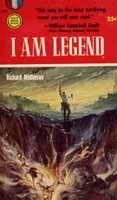
I'm one of those people that sits through the credits at the movie theater. I don't need to know best grip or stuff like that, mostly I look at the writing credits and the music credits. After seeing the 2007 movie "I am Legend" starring Will Smith, I saw that the movie was "based on the novel by Richard Matheson." Many times the term "based on" is used very loosely, for example, look at the movie "Lawnmower Man" it was "based on" the story by Stephen King. It had so little to do with the Stephen King story that Stephen King wanted his name off the film, in fact it had NOTHING to do with the story.
That all being said, I thought the movie was very well done and wanted to read the book. Well let me tell you I was a bit let down in the fact that it was merely based on the novel. The character portrayed by Smith was named Robert Neville, as in the book. He was the last living human (sort of) and strange creatures were created by a disease. Those are the only similarities. Okay the basic survival storyline is similar also. But the zombies in the movie are actually vampires in the book.
As I was reading this book I was thinking, I've seen this movie, but not the Will Smith version. After awhile it dawned on me, I had seen the movie. The lead was played by Vincent Price. Yes the 1964 movie "The Last Man on Earth" was based on the novel. However in this case it was based less loosely. After some research I found that the 1971 Charleton Heston film, "Omega Man," was also based on the novel. Out of all three of the movies "The Last Man on Earth" was the one closest to the the book.
The 2007 version had zombies instead of vampires, the 1971 version went to a weird military protest view and had more than one man left on earth. But hey, that's Hollywood.
Okay here's what the actual book has, which, by the way, is a very good sci-fi/horror read while at the same time having something to say about humanity. "I Am Legend," the novel, follows the life of Robert Neville who is the last man alive on Earth after a disease has turned everyone else into vampires. The disease is a by-product of war. Neville spends his days restringing fresh garlic and hanging mirrors and crosses to keep the vampires at bay. His nights are spent drinking alone in his home turned fortress as the vampires bang on his door. One vampire in particular is a friend (back when he was human) and constantly taunts Neville to come out. Also during the days Neville drives through town finding supplies and killing the vampires, the sleep during the day after all.
After hitting his low point with the drinking Neville decides to try and find a cure for the disease. He soon learns the nature of the bacteria causing the vampirism that claimed humanity, including his wife and daughter. During his research he notices a stray dog, after feeding the dog and eventually gaining the dogs trust a little, Neville finally has a companion. Eventually the dog contracts the disease and Neville must work harder to find a cure.
Eventually Neville sees a woman (during daylight hours) and after some time he gains her trust, although he never fully trusts her. The drama then unfolds as the woman becomes more and more mysterious while at the same time fishing for information from him.
Without becoming too much of a spoiler, I will warn you that this book does not have the happy ending of the movies, but a very interesting view on the philosophies of humanity.
Labels: book review, books, horror, i am legend, richard matheson, Science-Fiction, vampires, will smith, zombies
posted by Gil T. @ 9:23 PM


"Isaac Asimov's Robot City Book 6: Perihelion" by William F. Wu. (published by Ace Books 1988)
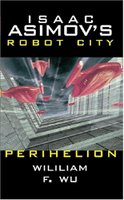
Well sadly I've come to the end of the series of books that is "Robot City." It has been a great endeavor with some ups and downs in both reading of the series and the adventures of "David/Derec" and "Katherine/Ariel." Before I go too much further allow me to recap the idea behind these books.
Isaac Asimov's Robot City is a series of novels written by various authors and loosely connected to Isaac Asimov's Robot Series. It takes place between The Robots of Dawn and Robots and Empire. The novels were written in response to a writing challenge issued by Asimov to write a series involving the Three Laws of Robotics, which brought about a collaboration of several talented authors.
The books in this series are:
1. Odyssey by Michael P. Kube-McDowell (1987)
2. Suspicion by Mike McQuay (1987)
3. Cyborg by William F. Wu (1987)
4. Prodigy by Arthur Byron Cover (1988)
5. Refuge by Rob Chilson (1988)
6. Perihelion by William F. Wu (1988)
One thing this series introduces is the concept of aliens. In Asimov's universe there were no other intelligent lifeforms other than human and robot. In the later books by Asimov he explained that this could be because the robots were sent ahead of humanity to terraform planets and thus destroying alien life forms. So maybe some aliens could have "survived." In my humble opinion I think Asimov simply wanted to explore humanity through robots and their interaction with humans and just left out the aliens.
This book is the final book in the series and the second in the series by writer William F. Wu. In Perihelion, Derec and Ariel have returned to Robot City from Earth to find Dr. Avery (the creator of Robot City) and find out why he has "infected" Derec with Chemfets, molecule sized robots that are taking over Derec's Body.
Upon arrival the team of Derec, Ariel, Wolruff (the caninoid alien) and Mandlebrot (the hybrid robot created by Derec) find that Robot City has pretty much covered the entire planet and the robots are all finishing up tasks and instructed to reprogram to "migration programming." While trying to solve this puzzle of migration programming and find Dr. Avery the team must avoid Hunter robots that wish to capture them.
As they get closer to Avery, Derec's infection of Chemfets leaves him immobilized. The team is joined by Jeff Leong, the man who was turned into a cyborg in book 3. Jeff is back to help them off the planet thinking they were still stranded as when he last left them. As it turns out Jeff had met Dr. Avery when Dr. Avery sought Jeff's fathers assistance in creating Robot City.
The books climax is one that not only wraps up the entire series and solves all the mysteries, but also leaves space for the series to continue. In fact the last page of the book says, "Robot city continues in book #7." Sadly no book 7 was ever written. Actually that's not quite true...Asimov did the same with this series in another series called "Robots & Aliens." That series is said to continue where this one left off. Guess I'll be looking for that series next.
All in all the experiment was a success and I think all the authors captured the spirit of Asimov's robots. Maybe a standard should be set here.
Labels: book review, books, Isaac Asimov, robot city, robotics, robots, Science-Fiction, william f. wu
posted by Gil T. @ 2:07 PM


"Stiff: The Curious Lives of Human Cadavers" by Mary Roach (pub. W. W. Norton & Company 2003)
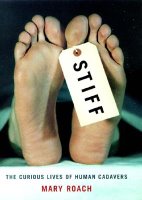
I recently read Mary Roach's book, "Spook: Science Tackles the Afterlife," and was impressed by the way the author not only could explain the science of death and dying but that she did it with great wit. I mean there were times while reading the book I would catch myself laughing out loud, and have to look around and make sure no one thought I was a bit crazy. But no one did...or at least none that would admit it. Anyway, after that treat of non-fiction, educational but in a fun way, book I had to go back and read her earlier book, I was not let down. This book provided the learn something new but have some laughs along the way fun that I've now come to expect from Mary Roach.
Keep in mind she does look at this in a fun way, but in no way does Mary Roach make fun of the dead or dying. Humor with class and education is the best way to describe what is in this book.
In "Stiff:..." Mary Roach examines the many things that happen after a person ceases being a person. Mostly these people have donated their bodies for research, but in the past it was not always that way. So not only is there a bit of exploring what a cadaver is expected to go through, Mary Roach also gives a bit of a history lesson on the dead.
I think this book is best summed up with a list of the chapters, so here's a list of the chapters.
1. A Head Is a Terrible Thing to Waste: Practicing surgery on the dead
2. Crimes of Anatomy: Body snatching and other sordid tales from the dawn of human dissection
3. Life After Death: On human decay and what can be done about it
4. Dead Man Driving: Human crash test dummies and the ghastly, necessary science of impact tolerance
5. Beyond the Black Box: When the bodies of the passengers must tell the story of a crash
6. The Cadaver Who Joined the Army: The sticky ethics of bullets and bombs
7. Holy Cadaver: The crucifixion experiments
8. How to Know if You're Dead: Beating-heart cadavers, live burial, and the scientific search for the soul
9. Just a Head: Decapitation, reanimation, and the human head transplant
10. Eat Me: Medicinal cannibalism and the case of the human dumplings
11. Out of the Fire, into the Compost Bin: And other new ways to end up
12. Remains of the Author: Will she or won't she?
As you can see lots of interesting subjects and each chapter more informative and entertaining than the previous. Keep in mind this book is not for the squeamish. I will have to say that the book as a huge squirm factor, by that I mean if you , like me, have a hard time listening to very descriptive discussions about body parts and cutting into same and squirm around in your seat when you hear or read such, you'll be squirming throughout this book. However, I found the book very fascinating, informative and yes entertaining so I squirmed but read on.
Seriously you know you're in for some squirming when the book opens up with:
"The human head is of the same approximate size and weight as a roaster chicken. I have never before had the occasion to make the comparison, for never before today have I seen a head in a roasting pan. But here are forty of them, one per pan, resting face-up on what looks to be a small pet-food bowl. The heads are for plastic surgeons, two per head, to practice on...."
After this book I've decided I'm still not sure about what to do with my body after I'm done with it. I do support the "harvesting" of my organs but for the rest, i'm thinking seriously about the composting idea. (read chapter 11)
Labels: book review, books, born in death, cadavers, mary roach, non-fiction, Science-Fiction, stiff
posted by Gil T. @ 7:33 PM


"Isaac Asimov's Robot City Book 5: Refuge" by Rob Chilson (pub 1988)

I have just finished reading book 5 of this "Robot City" series and I will have to say out of the the 5 so far this one seems the closest to the universe created by Isaac Asimov that gave us the 3 laws of robotics and even laws of humanics later used in the Foundation series. Before I go too far let me recap what this series is about.
In science fiction, the Three Laws of Robotics are a set of three rules written by Isaac Asimov, which almost all positronic robots (designated by their Asimov created positronic brains) appearing in his fiction must obey. Introduced in his 1942 short story "Runaround", although foreshadowed in a few earlier stories, the Laws state the following:
- A robot may not injure a human being or, through inaction, allow a human being to come to harm.
- A robot must obey orders given it by human beings except where such orders would conflict with the First Law.
- A robot must protect its own existence as long as such protection does not conflict with the First or Second Law.
Isaac Asimov created these laws as more or less a challenge to himself for writing his novels. Later, Asimov added the Zeroth Law: "A robot may not harm humanity, or, by inaction, allow humanity to come to harm;" the rest of the laws are modified sequentially to acknowledge this. He created murder mysteries in space using the 3 laws and the Detective Elijah Bailey. Bailey would receive help from R. Daneel Olivaw, a human appearing robot. Many science fiction writers have used the ideas of Asimov's robots, but no other author could directly state 3 three laws. Even the positronic brain was copied in the series "Star Trek: The Next Generation." Commander Data had a positronic brain. Asimov was honored to have many sci-fi writers copy the ideas but the laws were his and he did not allow this. Not until the Robot City series of books. This series of 5 books was a challenge to 4 different Sci-Fi writers to write stories based solely on the laws and Asimov's universe.
Isaac Asimov's Robot City is a series of novels written by various authors and loosely connected to Isaac Asimov's Robot Series. It takes place between The Robots of Dawn and Robots and Empire. The novels were written in response to a writing challenge issued by Asimov to write a series involving the Three Laws of Robotics, which brought about a collaboration of several talented authors.
The books in this series are:
1. Odyssey by Michael P. Kube-McDowell (1987)
2. Suspicion by Mike McQuay (1987)
3. Cyborg by William F. Wu (1987)
4. Prodigy by Arthur Byron Cover (1988)
5. Refuge by Rob Chilson (1988)
6. Perihelion by William F. Wu (1988)
One thing this series introduces is the concept of aliens. In Asimov's universe there were no other intelligent lifeforms other than human and robot. In the later books by Asimov he explained that this could be because the robots were sent ahead of humanity to terraform planets and thus destroying alien life forms. So maybe some aliens could have "survived." In my humble opinion I think Asimov simply wanted to explore humanity through robots and their interaction with humans and just left out the aliens.
In Book 5 of Robot City "Refuge" Rob Chilson takes Derec and Katherine/Ariel back to planet Earth via a "Key to Perihelion." The Key takes them back to an apartment in St. Louis on earth. (side note, Rob Chilson is a comic book writer from Kansas City, Missouri, and has some really neat insight into the St. Louis of the future.) Katherine/Ariel is still suffering from the mysterious illness and it seems to be getting worse. All the "spacer" doctors told her there was no cure, thus the reason she was wandering the universe and found Derec. The illness is not incurable on Earth. The Earth doctors are only able to treat her after her memory loss has started so Derec records what memories they have shared so they can be fed back to her and hopefully restoring them after the illness is cured. Derec at that time learns the reason for his amnesia is this same illness but he was intentionally given the virus...but why??? So another mystery pops up.
Another thing found in Derec are a type of robot infection in his bloodstream taking over his body. He now must get back to Robot City. If you read book 4 or read my review of that book you may know they had only just recently escaped Robot City...now they have to return and confront Dr. Avery and find the reason for his intentional infection of both the disease and the robot virus.
As they leave Earth and are headed back to Robot City, the Alien, Aranimas, finds them and attacks them. Aranimas is looking for a Key to find Robot City so he can have robots of his own. The aliens don't possess the ability to create robots.
I'll leave the space fight up to you to read and find the outcome...or wait until my review of the final book in the series. But I want to leave you with one final comment. This book is the closest in the series in capturing the entire universe created by Asimov with the steel and concrete caves that have become the cities on Earth. While the others work great on capturing the essence of the robots and the laws of robotics, this book captures the entire Asimov universe.
Labels: book review, books, Isaac Asimov, refuge, rob chilson, robot city, robotics, robots, Science-Fiction
posted by Gil T. @ 8:15 PM


"Ceremony in Death" by JD Robb (pub. 1997)
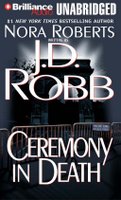
Conducting a top secret investigation into the death of a fellow police officer has Lieutenant Eve Dallas treading on dangerous ground. She must put professional ethics before personal loyalties. But when a dead body is placed outside her home, Eve takes the warning personally. With her husband, Roarke, watching her every move, Eve is drawn into the most dangerous case of her career. Every step she takes makes her question her own sense of right and wrong - and brings her closer to a
confrontation with humanity's most seductive form of evil...
That is how the book's cover lures you in, but let me tell you that, there is oh so much more in this book. Before I talk about the book I've got to get this off my chest. I've mentioned before that the "...in Death" series of books by JD Robb would make a great series, especially on the Sci-Fi channel. The book has great characters in which an ensemble cast could easily bring to life. (most of the work is already written into the books.) There is great action and mystery and some great sci-fi touches that make the stories more fun. On top of all that the books feature holiday linked themes that work really well on tv series. There are a couple of the books that take place around the holidays (Thanksgiving, Christmas, New Years). Then there is this book which would make a great Halloween episode. The setting is Halloween 2058 and the police officer's death is pointing ot a witch's spell or possible from the Church of Satan.
The fellow police officer whose death begins all this died of a heart condition. However he never had a heart condition on record. His former partner and best friend happens to be the best Electronics Division cop, Feeny. Yes the same Feeney that taught Dallas the ropes and is mentor/ father figure to her as well. Commander Whitney puts Dallas on the case to prove that Feeney or his former partner were doing anything wrong. To do this Dallas has to work behind Feeney's back. Feeney gets word of this and is hurt because he wasn't in and takes it out on Dallas.
The investigation leads to a circle of witchcraft both black and white and a battle between the two. Oh yeah and it just so happens to be Halloween. Dallas now has to not only prove 2 cops innocence ( one dead and one her mentor) she also has to investigat 3 more homicides. One is nailed to an inverted pentagram outside her home. Being the practical cop Dallas works with only logic and is not distracted by con artists or "witches".
So if you are looking for some Halloween fare this fall try this book for fun.
Labels: book review, books, ceremony in death, in death, j. d. robb, nora roberts, Science-Fiction
posted by Gil T. @ 11:03 PM


"Born In Death" by JD Robb (pub 2006)
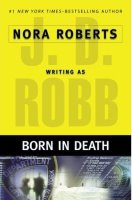
If you have read any of the books in the "...in Death" series, you pretty well know how busy Lt. Eve Dallas, homice, NYPSD, can be. In this book the author decides that's not enough and really lays it on Eve Dallas, but on top of being busy this book is fun, especially at the end. I will warn you there is a bit of a spoiler in this review so you may not want to read the end. The spoiler will not be about the case(s) Dallas is working on but about her friend Mavis Freestone, the rockstar.
In the sci-fi world of Lt. Eve Dallas, cop work still comes down to talking to folks and in this case tracing the money. However, being the future and being married to Roarke (the wealthiest man on or off planet) there are some neat tools to help with the money trail. That is just what is needed here. Two accountants are found murdered and Dallas is primary detective on the cases. It seems as though the accountants found something big that could get someone in serious trouble, they were going to try to expose the criminals before going to the police. But that's what got them killed. Now Lt. Dallas has to find what they found.
On top of this Eve and Roarke are attending birthing coach classes, not because Eve is pregnant, but because her best friend Mavis Freestone, rockstar, vidstar and party animal is about to pop and wants Eve and Roarke to be there at the birthing, along with Mavis' cohab partner , fashion designer Leonardo. Eve and Roarke are horrified by the idea of being present at the birth, but will do this favor for their friend.
One of the women Mavis met at the coaching classes is a single woman who is also about to pop. Tandy has just moved to New York from London and is Mavis' pregnant pal. When Tandy doesn't show up to Mavis' baby shower, Mavis gets worried and as victim of hormones falls apart worrying about Tandy. She makes Dallas promise to find her. So now Dallas has 2 cases to work a double homicide case which turns up a third homicide, to find a missing person, and to be prepared to be Mavis' coach for the birth.
As it turns out the missing persons and the homicides seem to tie together. So strap yourself in for this thrill-a-second sci-fi detective novel by JD Robb.
Now for the somewhat of a spoiler portion of the review. One of the many things I've come to appreciate about this series of books is that they are well rounded in action, suspense, thrills, mystery and even some comedy. The comedy aspect really comes in to play at the end of this book when Mavis gives birth. The scene described with Dallas, Roarke, Somerset, Mavis, Leonard, et. al. is just some really good comedy that almost falls in the slapstick category. This scene alone made the entire book worth the read. There are some serious emotional highs in the finale of this book.
Labels: book review, books, born in death, eve dallas, in, in death, j. d. robb, lt. eve dallas, nora roberts, roarke, Science-Fiction
posted by Gil T. @ 9:34 PM


"Origin in Death" by J.D. Robb (pub. 2005)
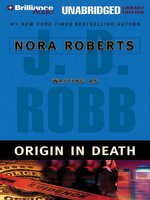
I'm continuing in my quest to read all the books in the "...in Death" series by J.D. Robb, a.k.a. Nora Roberts. This is the sci-fi series about NYPSD Lt. Eve Dallas, Homicide division. Lt. Dallas kicks butt and takes names, most of the time she forgets the pencil, but she always gets the job done. I accidentally read one of these books thinking it was just a straight sci-fi detective book. I was surprised to find they were written by romance/thriller writer Nora Roberts. I'm glad I have discovered these books. They are fun and full of excitement. Especially this one.
"Origin in Death," I'm going to go out on a limb and say this is the best book in the series. This has got all the great stuff of a great sci-fi/Detective novel. In fact this book would give Isaac Asimov and his R. Daneel Olivaw books a good run for the money. Great gadgets, great sci-fi/bordering on "could happen now" plot and, as with all the books, great action/thrills.
A well known doctor of cosmetic surgery is found murdered. The murder all points to a professional hit. The murderer was in, murdered with one stab of a scalpel, and out with no detection and within a matter of minutes. The murderer is caught on all security cameras and is an extremely beautiful woman. Her face does not turn up in any face recognition databases but her ID used to get past the 'droid and human security makes her to be a resident of Madrid, Spain.
This doctor, Doctor Icove, and his son, Dr. Icove, Jr. run a unique center which not only is the place for vidstars to get work done in complete privacy but also gives back to the community in many ways, donations of money and surgery for victims. The good doctors are saints. But Eve Dallas doesn't believe anyone can have that perfect of a record. Something has to be hidden, and to solve this homicide Eve will have to find that something.
Eve finds secret files in Icoves computers and these files refer to numerous cases of women ages 17-22 in which the records not only list healt records but IQ results. Not normal for cosmetic surgery. The first suspicion is that the doctor was experimenting with 'droid/human hybrids, which were outlawed back in the 2030's. But after following the money trail even more of a danger is discovered. After Dr. Icove Jr. is found murdered, Eve now has 2 murders that lead to a hidden institution and dangerous cloning experiments.
One thing I've always mentioned when writing about these books is the great characterization Robb/Roberts has created within these books. One of my favorites is Eve's husband Roarke. To some Roarke may be the "deus ex machina," because he is one of the wealthiest men on and off planet and that he has some of the coolest gadgets. Roarke is always at Eve's disposal and they make a great crimefighting team. Oh yeah that and his former criminal side sneaks in every so often, for example, his unregistered computer system that can find anyone and anything without being detected by CompuGuard.
As a side note, if you like audiobooks or would like to give audiobooks a try, I HIGHLY recommend checking these out. They are read by Susan Ericksen, and she provides great vocal qualities to each character so that you feel as if you are listening to a radio play.
Labels: book review, books, in death, j. d. robb, nora roberts, Science-Fiction
posted by Gil T. @ 8:35 PM


"Visions in Death" by J. D. Robb (pub. 2004)
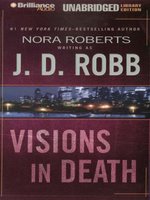
Once again the butt-kicking NYPSD cop, Lt. Eve Dallas, is primary on a series of murders. The murders seem to be some sort of work of a serial killer. All victims are brutally raped and beaten then murdered and their eyes removed. Sounds like a grisly case and yes it is. This time around Dallas gets some help from a psychic who is seeing visions of the murders.
The psychic is pretty much only affirming what Dallas and her partner Detective Peabody already know, the murderer is a man who has a vengeance against women and is really, really big in size and strength. The key to wrapping this case will be the murder weapon, red chording, which is used to strangle and then tie the victims in a praying position for discovery. The chording is found in most craft stores, but Dallas uses all her faculties to wrap this one. Besides that this is the future and computers are much more powerful and everything is accessible.
One thing with all the "...in Death" books by J.D. Robb is that there is always some sort of separate meaning to the books. In this one it is the definition and discovery of friendship. Because of her troubled life Dallas has never allowed herself to have friends, not close ones anyway. This book develops as Dallas is discovering how tight her circle of friends really is and the strong bonds held between them. She also tells Peabody the entire story of her past in forming a tighter bond with her police partner and friend.
Peabody becomes a target of the murderer and (spoiler alert here!!!!) she is severely beaten and ends up in the hospital. The friendships and bonds become even more clear at this point and the extremely well written characters in the series all surround Peabody in her hospital room as she recovers and the reader is given the great treat of really feeling like being a part of the scene.
With that spoiler alert I will also let hang this; there is a great twist at the end of the book so just when you think the crime is solved and the murderer put away.....hang on to your socks.
I've somewhat complained in the past about the fact that these books are really written by romantic thriller author Nora Roberts, and that she always throws in the romance in the books. In this book she really makes it work with the discovery of friendship and I really appreciated that. I still am not fond of all the sex in these books. Don't get me wrong, I'm by no means a prude, but I just don't like reading about folks having sex, bordering on the erotica, the sex scenes in these books allow me to skip several pages and getting the book read much faster.
Labels: book review, books, in death, interlude in death, j. d. robb, nora roberts, rapture in death, Science-Fiction, visions in death
posted by Gil T. @ 11:31 PM


 "Dune: House Atreides"
"Dune: House Atreides" Planet of the Apes
Planet of the Apes “When Shadows Fall”
“When Shadows Fall”
 "Juggler of Worlds"
"Juggler of Worlds" Brave New World
Brave New World  One Second After
One Second After
 Danger in the Dark
Danger in the Dark
 Heretics of Dune
Heretics of Dune "Judgment in Death"
"Judgment in Death" "Reunion in Death"
"Reunion in Death" 
 Doctor Who – The Evil of The Daleks
Doctor Who – The Evil of The Daleks
 Once again we join New York's best homicide detective in the year 2059, this time it's not really a real homicide case that Lt. Eve Dallas is thrust into. Sure, there are dead bodies and a murder mystery for this kick-butt future cop to solve but this time a lot more is at stake and the culprits are terrorists.
Once again we join New York's best homicide detective in the year 2059, this time it's not really a real homicide case that Lt. Eve Dallas is thrust into. Sure, there are dead bodies and a murder mystery for this kick-butt future cop to solve but this time a lot more is at stake and the culprits are terrorists.  Any true science-fiction fan can tell you that one of the classics of Sci-Fi is the Dune Series created by Frank Herbert. If you have taken it upon yourself to read the entire series you'll remember that Frank Herbert died and left the series a real cliffhanger. Some dedicated dune fans will say that is what he intended but some will say he had more to write. Frank Herbert's son, Brian has teamed up with another sci-fi author, Kevin J. Anderson and working with Franks notes and stored treasures left behined have brought the Dune series to a close. They have also augmented the series with some great prequels also using ideas they found in Frank Herbert's many writings, and to this day they are adding more stories and books to the Duneverse with the recent publication of "Paul of Dune." (note: I'll be reviewing this book soon...I have the audiobook sitting on my shelf waiting for my devouring.
Any true science-fiction fan can tell you that one of the classics of Sci-Fi is the Dune Series created by Frank Herbert. If you have taken it upon yourself to read the entire series you'll remember that Frank Herbert died and left the series a real cliffhanger. Some dedicated dune fans will say that is what he intended but some will say he had more to write. Frank Herbert's son, Brian has teamed up with another sci-fi author, Kevin J. Anderson and working with Franks notes and stored treasures left behined have brought the Dune series to a close. They have also augmented the series with some great prequels also using ideas they found in Frank Herbert's many writings, and to this day they are adding more stories and books to the Duneverse with the recent publication of "Paul of Dune." (note: I'll be reviewing this book soon...I have the audiobook sitting on my shelf waiting for my devouring. The last book I reviewed by Chuck Palahniuk ("Choke"), I remarked about how I love non-linear story telling and that I appreciate especially the non-linear works of Mr. Palahniuk. This book I think was the perfect non-linear book. At first though I was let down by the time-line structure. Basically the book is a history of the would-be / could-be messianic character of Buster "Rant" Casey, told through anecdotes from various characters who knew Rant or in some cases technical/governmental advisers. It's not until about halfway through the book that you realize the beginning may be the ending, or the ending may be the middle or the end may be, or the middle may not have ever happened, or any combination thereof. At this point in reading, the book became more of a dark humorous novel to something of weird existentialism.
The last book I reviewed by Chuck Palahniuk ("Choke"), I remarked about how I love non-linear story telling and that I appreciate especially the non-linear works of Mr. Palahniuk. This book I think was the perfect non-linear book. At first though I was let down by the time-line structure. Basically the book is a history of the would-be / could-be messianic character of Buster "Rant" Casey, told through anecdotes from various characters who knew Rant or in some cases technical/governmental advisers. It's not until about halfway through the book that you realize the beginning may be the ending, or the ending may be the middle or the end may be, or the middle may not have ever happened, or any combination thereof. At this point in reading, the book became more of a dark humorous novel to something of weird existentialism. I'm one of those people that sits through the credits at the movie theater. I don't need to know best grip or stuff like that, mostly I look at the writing credits and the music credits. After seeing the 2007 movie "I am Legend" starring Will Smith, I saw that the movie was "based on the novel by Richard Matheson." Many times the term "based on" is used very loosely, for example, look at the movie "Lawnmower Man" it was "based on" the story by Stephen King. It had so little to do with the Stephen King story that Stephen King wanted his name off the film, in fact it had NOTHING to do with the story.
I'm one of those people that sits through the credits at the movie theater. I don't need to know best grip or stuff like that, mostly I look at the writing credits and the music credits. After seeing the 2007 movie "I am Legend" starring Will Smith, I saw that the movie was "based on the novel by Richard Matheson." Many times the term "based on" is used very loosely, for example, look at the movie "Lawnmower Man" it was "based on" the story by Stephen King. It had so little to do with the Stephen King story that Stephen King wanted his name off the film, in fact it had NOTHING to do with the story.  Well sadly I've come to the end of the series of books that is "Robot City." It has been a great endeavor with some ups and downs in both reading of the series and the adventures of "David/Derec" and "Katherine/Ariel." Before I go too much further allow me to recap the idea behind these books.
Well sadly I've come to the end of the series of books that is "Robot City." It has been a great endeavor with some ups and downs in both reading of the series and the adventures of "David/Derec" and "Katherine/Ariel." Before I go too much further allow me to recap the idea behind these books. I recently read Mary Roach's book, "Spook: Science Tackles the Afterlife," and was impressed by the way the author not only could explain the science of death and dying but that she did it with great wit. I mean there were times while reading the book I would catch myself laughing out loud, and have to look around and make sure no one thought I was a bit crazy. But no one did...or at least none that would admit it. Anyway, after that treat of non-fiction, educational but in a fun way, book I had to go back and read her earlier book, I was not let down. This book provided the learn something new but have some laughs along the way fun that I've now come to expect from Mary Roach.
I recently read Mary Roach's book, "Spook: Science Tackles the Afterlife," and was impressed by the way the author not only could explain the science of death and dying but that she did it with great wit. I mean there were times while reading the book I would catch myself laughing out loud, and have to look around and make sure no one thought I was a bit crazy. But no one did...or at least none that would admit it. Anyway, after that treat of non-fiction, educational but in a fun way, book I had to go back and read her earlier book, I was not let down. This book provided the learn something new but have some laughs along the way fun that I've now come to expect from Mary Roach. I have just finished reading book 5 of this "Robot City" series and I will have to say out of the the 5 so far this one seems the closest to the universe created by Isaac Asimov that gave us the 3 laws of robotics and even laws of humanics later used in the Foundation series. Before I go too far let me recap what this series is about.
I have just finished reading book 5 of this "Robot City" series and I will have to say out of the the 5 so far this one seems the closest to the universe created by Isaac Asimov that gave us the 3 laws of robotics and even laws of humanics later used in the Foundation series. Before I go too far let me recap what this series is about.
 If you have read any of the books in the "...in Death" series, you pretty well know how busy Lt. Eve Dallas, homice, NYPSD, can be. In this book the author decides that's not enough and really lays it on Eve Dallas, but on top of being busy this book is fun, especially at the end. I will warn you there is a bit of a spoiler in this review so you may not want to read the end. The spoiler will not be about the case(s) Dallas is working on but about her friend Mavis Freestone, the rockstar.
If you have read any of the books in the "...in Death" series, you pretty well know how busy Lt. Eve Dallas, homice, NYPSD, can be. In this book the author decides that's not enough and really lays it on Eve Dallas, but on top of being busy this book is fun, especially at the end. I will warn you there is a bit of a spoiler in this review so you may not want to read the end. The spoiler will not be about the case(s) Dallas is working on but about her friend Mavis Freestone, the rockstar. I'm continuing in my quest to read all the books in the "...in Death" series by J.D. Robb, a.k.a. Nora Roberts. This is the sci-fi series about NYPSD Lt. Eve Dallas, Homicide division. Lt. Dallas kicks butt and takes names, most of the time she forgets the pencil, but she always gets the job done. I accidentally read one of these books thinking it was just a straight sci-fi detective book. I was surprised to find they were written by romance/thriller writer Nora Roberts. I'm glad I have discovered these books. They are fun and full of excitement. Especially this one.
I'm continuing in my quest to read all the books in the "...in Death" series by J.D. Robb, a.k.a. Nora Roberts. This is the sci-fi series about NYPSD Lt. Eve Dallas, Homicide division. Lt. Dallas kicks butt and takes names, most of the time she forgets the pencil, but she always gets the job done. I accidentally read one of these books thinking it was just a straight sci-fi detective book. I was surprised to find they were written by romance/thriller writer Nora Roberts. I'm glad I have discovered these books. They are fun and full of excitement. Especially this one. Once again the butt-kicking NYPSD cop, Lt. Eve Dallas, is primary on a series of murders. The murders seem to be some sort of work of a serial killer. All victims are brutally raped and beaten then murdered and their eyes removed. Sounds like a grisly case and yes it is. This time around Dallas gets some help from a psychic who is seeing visions of the murders.
Once again the butt-kicking NYPSD cop, Lt. Eve Dallas, is primary on a series of murders. The murders seem to be some sort of work of a serial killer. All victims are brutally raped and beaten then murdered and their eyes removed. Sounds like a grisly case and yes it is. This time around Dallas gets some help from a psychic who is seeing visions of the murders.




























